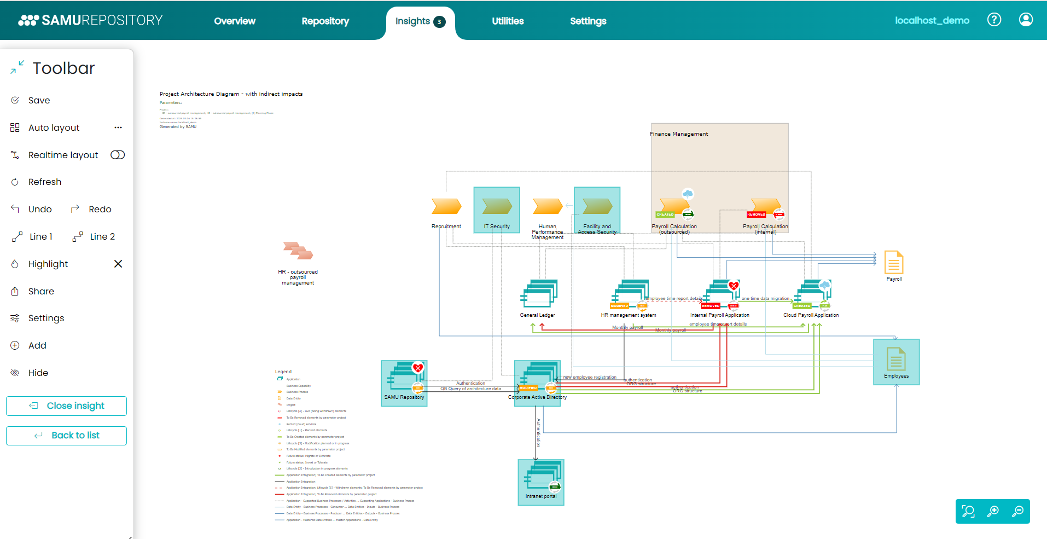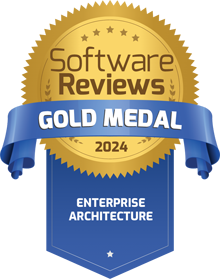Plan and manage digital transformation
Fast estimation for scoping
Estimate a new demand’s complexity, resourcing and cost assessment quickly.
“I can give a pretty good cost and resource estimate on the new demands to business teams within a few hours. This means that we as a company can go to market with the right offering faster. Business units started to see my team as a key information source for prioritizing and planning their disruptive ideas.” –, chief enterprise architect, Telecommunications Company
Business success often depends on selecting ideas that generate the greatest positive impact and then implementing those quickly. This is exactly what enterprise architects, empowered with a live knowledge base, can help identify. Thus, EA will have a direct influence on the organization’s competitiveness.
During the planning phase, it is not necessary to know the exact breadth of a project – however, what the decision makers really need to know is the approximate magnitude of the effort required and thus the costs and resources involved. Is it 10k, 500k or 2m? They can then compare this cost estimate with the anticipated business revenue benefits, and then decide whether to proceed or not.
From idea to rough specification
A business idea typically will never be too detailed. Discussing and analyzing it for a period, will make it more definitive. Discussing and analyzing it with a supportive enterprise architect, will bring clarity and some idea boundaries and should provide new perspectives to the business stakeholders.
High-level plan and estimate
Once the idea is defined, enterprise architects can create a high-level solution design with the help of an up-to-date EA knowledge base. They will typically do 3 things:
1. Create a new proposed project in SAMU;
2. Specify the modifications it will do on the architecture: the capabilities, applications, components and dependencies it will create, modify or remove;
3. Verify the design with the idea owner;
Such design activities, will add new future components and describe the proposed changes to the existing components. At this stage, it is not needed for architects to detail these modifications in depth – those can be added later and updated as we progress with the project. Upon marking a component as something to be modified, SAMU pulls in the existing dependencies of the chosen item – this is done to help assess all the consequences of a particular change to an object and are done at an early stage of the process.
Architects will get a pretty good assessment of the overall impact of the idea. Business teams will receive a good estimate of the costs and resources needed in order to deliver the solution to the desired idea.
Drop it or work it out
Fast costing, based on the initial high-level solution design, will empower business teams to make decisions about the business value of emerging ideas very quickly. Prioritizing the ideas, based on real cost compared to business benefits, allows teams to effectively lead the organization and achieve a competitive edge.
Undecided? Need more specific information? – Work out the project architecture design with the field architects in greater detail. This will allow the stakeholders to collaborate over one design, built from the same shared components from the EA repository. This will ensure a common understanding of the required changes.
We have customers, who include the high-level solution designs into tendering documents as a technical description for the required solution. This allows tenderers/procurement to have the architecture required information in a standard structure, which should increase clarity and result in receiving better quality proposals and solutions.
Continuous governance
High-level solution designs provide an end-to-end architecture context that forms a basis for a successful implementation. This is important not only for the initial decision making, but will also lead to better decisions during the project implementation:
– Support decision making throughout the project, as emerging changes are quickly evaluated – which is especially valuable in agile method-based projects;
– After go-live, this architecture design becomes the baseline for business operations and provides a clear overview of the delivered solution;
– Support internal or external audits, when compliance to data handling, business continuity or security must be demonstrated;
– Future projects may build onto or use parts of the delivered architecture design. Thus, plans are not prepared for a one-off project, but are re-usable providing a live assistance for future activities.
Therefore, plans are never static – they live continuously in a shared repository.
Join our satisfied customers!
Digitally conscious businesses who trust us










Why us?
We offer a Free SAMU Trial and/or a Free Proof of Concept (We set up the trial using customer data)
SAMU is extremely flexible, the meta-model is fully flexible, custom reports can be created, sophisticated user permission rights
Our Best Practice Model based on 20+ years of experience in delivering successful EA projects
SAMU has been developed using a bottom-up approach. Product development is based on real-life customer needs.
Customer satisfaction and our approach. Each customer is unique. We strive to bring real value and to have a successful EA practice.
Powerful visualizations: Our visualizations are all data-driven generated from the live repository with multiple lifecycle views available.
Integration capabilities: Sophisticated API to automate data upload and maintain quality in the repository.
Don't take our word for it!

Atoll Technologies Ltd. EA tool SAMU is a leader in Info-Tech Research Group /SoftwareReview 2024 Enterprise Architecture Data Quadrant Report.
![]()

„Atoll Technologies Ltd.is the dominant vendor for EA tools in the Middle East. It also has regional strength in Central and Eastern Europe, and can provide strong support to these otherwise underserved markets."
![]()

Atoll Technologies Ltd. EA tool SAMU is included in the Forrester Now Tech: Enterprise Architecture Management Suites, Q2 2022.
![]()



